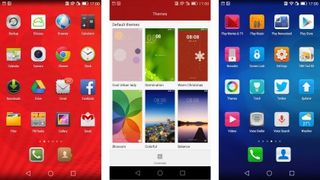Why you can trust TechRadar
Easily one of the best features of the Huawei Ascend G7 is that you can look at the price tag, then at the hardware it packs, then double-check that you didn't misread how much it costs.
Huawei really has done an excellent job of fitting in decent specifications in the Ascend G7, including a quad-core 1.2GHz processor and 2GB of RAM, which is pretty competitive at this price point.
This results in Android 4.4 KitKat performing well, with minimal lag or hang-ups. Scrolling through menus feels smooth, though there are sometimes noticeable delays when launching certain apps.
It's a shame that the Ascend G7 comes with the dated Android 4.4 KitKat, rather than the most recent Android 5.0 Lollipop, as I would have liked to have seen how the Ascend G7 coped with Google's latest operating system.
It means that Ascend G7 owners will miss out on some of the handy new features of Android 5.0 Lollipop, such as lock screen notifications, though hopefully an update will be made available later. Still, it's a disappointing misstep for a smartphone in 2015 that does a lot of things right.
Android has Huawei's Emotion 3.0 user interface (also known as EMUI 3.0) overlaid, giving a slightly tweaked feel to the stock Android experience. It does the job just fine, and thankfully there aren't many unwanted apps preinstalled, which is often the bane of smartphone manufacturers' custom interfaces.

One element of EMUI 3.0 that is a big change is the fact that there is no apps menu. Having switched from stock Android to EMUI 3.0, I spent a few moments searching in vain for the central apps menu that gives you an overview of all your installed applications.
Instead, every app that you install is plonked straight onto the home screen, and although this simplifies the operating system (handy for people who aren't used to using smartphones), it does mean that your home screen can quickly become cluttered and hard to navigate.
If you're not too keen on the default look of EMUI 3.0, you can easily change the theme via the included Themes app, granting the Ascend G7 a look that's more to your taste. The themes range from the horrid to the stylish and minimalist, so there's a good chance you'll find something you'll like.
Running the standard GeekBench 3 benchmark tests, the Ascend G7 scored 1398, which is roughly in line with what I was expecting of the device considering its specifications. The HTC Desire 816, which can be had for a similar amount of money as the Ascend G7 despite being slightly older, scored a bit higher with 1463. The Moto G, one of the best budget smartphones you can get your hands on, scored 1142 in the same tests, though it's a bit cheaper at £145 (US$270, AU$267).
These results mean that the Ascend G7 scores very well for its price range. It's a fair bit away from the scores of the OnePlus One (which netted an impressive 3050) and more expensive smartphones, but for the price you're getting pretty decent all-round performance.
Battery life
As I mentioned earlier, Huawei's desire to make a gorgeously designed smartphone means that the back panel isn't easily removable for access to the battery. However, before you groan too loudly, the good news is that Huawei has included a very capable battery, so you wouldn't really need to fiddle around with it anyway.

The 3000mAh capacity is nice to see, with smartphones the same price as the G7 coming with much smaller power packs. For example, the Desire 816 comes with just 2600mAh, which goes to show just how generous Huawei has been. Considering the screen is 720p, it means you should expect some pretty decent battery life from the G7.
In fact, during my time with the Ascend G7 the battery performance surpassed those expectations, with the device easily lasting two whole days without needing to be charged. I wasn't going easy on the Ascend G7 either, as I was listening to music, streaming TV shows via BBC iPlayer and making liberal use of the 4G LTE connection to browse the internet while out and about.
The only fault with the battery I could find is that although it takes a long time to discharge, it also takes a fair while to fully charge – we're talking a couple of hours to get it back up to 100%, but thanks to the healthy battery life it's unlikely you'll be caught out and in need of an emergency charge too often.
Our battery benchmark, which involved playing a high definition video for 90 minutes with the screen at full brightness, showed that the Ascend G7 lost 21% of its battery. The 2500mAh battery of the Huawei Ascend P7 lost 26% of its juice during the same test, while the HTC Desire 816 lost 25%.

Matt is TechRadar's Managing Editor for Core Tech, looking after computing and mobile technology. Having written for a number of publications such as PC Plus, PC Format, T3 and Linux Format, there's no aspect of technology that Matt isn't passionate about, especially computing and PC gaming. Ever since he got an Amiga A500+ for Christmas in 1991, he's loved using (and playing on) computers, and will talk endlessly about how The Secret of Monkey Island is the best game ever made.

